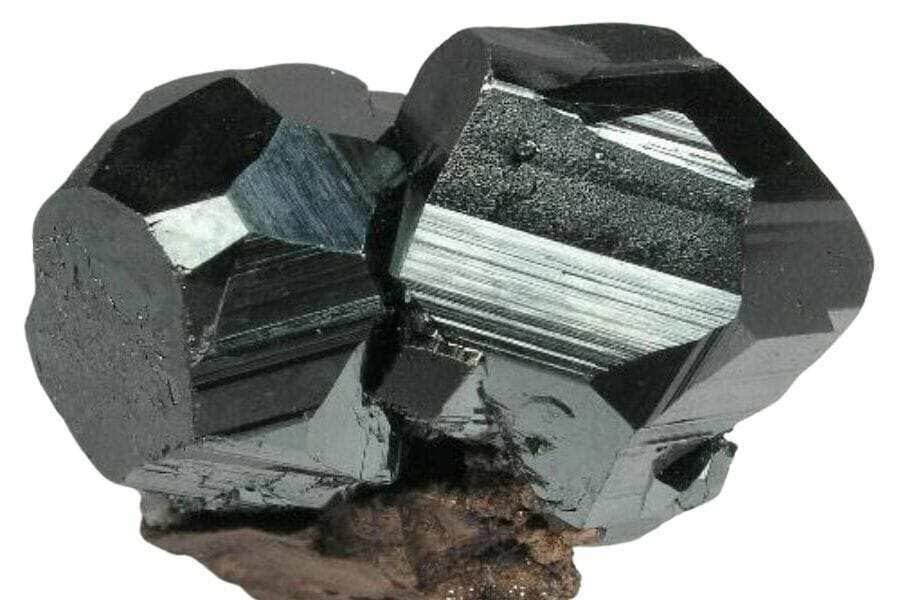Black rocks, minerals, and gems are as fascinating and dazzling as they are mysterious. While they’re often overlooked in favor of more colorful ones, their unique beauty and history draws interest and much admiration among rockhounds.
From the beautiful Obsidian and Hematite, which have been used since the ancient times as tools and decorative items, to Jet, which was popular during the Victorian era when it was carved into intricate designs, the value of black gemstones go beyond its beauty.
And did you know that black minerals are just as interesting? Just think of Magnetite, a mineral that’s said to have healing properties, and Galena, which was used in pencils in the past.
Indeed, there are lots of other interesting black rocks, minerals, and gems, and in this article, we’ll take a closer look at some of the most dazzling and mysterious ones out there.
We’ll also show you how you can identify everything we included here by color, hardness, clarity, and more. Let’s get started!
Black Gems and Crystals
Below are some of the most amazing, interesting, and dazzling black gems that you can find. Take a close look at their photos and see for yourself why black gems are worth the buzz.
Some of these you have probably seen before but others are likely going to be completely new to you!
Obsidian
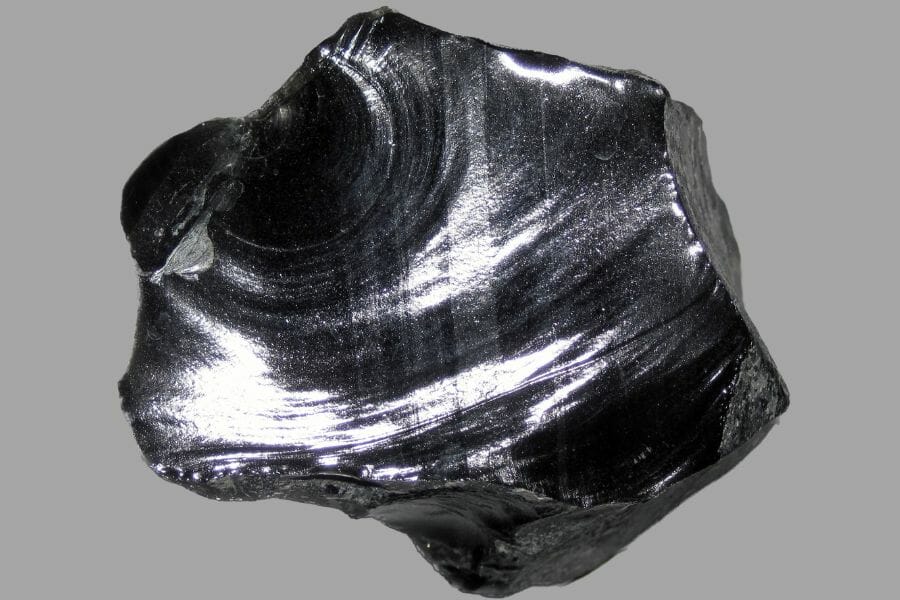
A beauty born out of danger— that’s what an Obsidian is! It’s a natural volcanic glass that’s formed when lava cools quickly, creating a black, shiny gem. For centuries, it’s been used by ancient civilizations for a variety of purposes: from tools like knives, arrowheads, and spears, to decorative items like jewelry and mirrors.
In ancient Mesoamerica, Obsidian was a highly-valued commodity, traded over long distances. The ancient Romans even used it to make surgical instruments because of its sharpness!
Another interesting thing is that it is also valued for its metaphysical properties. It is said to provide protection and grounding. Whether you believe it or not, we cannot deny the fact that this fascinating gem has played an important role in human history and continues to be valued for its unique properties to this day.
Fun Fact Obsidian is also known as "nature's glass" because of its amazingly shiny appearance. In fact, it was used by ancient Egyptians as mirrors. So the next time you look at the mirror, imagine looking at yourself through this black gemstone!
Where Obsidian is found
Obsidian is found in all sorts of places, like volcanoes, mountains, and even beaches. Places like Iceland and Italy have a lot of it, but you can also find it in the USA, like in Oregon, Wyoming, California, and even on the beaches of Hawaii.
You can also find Obsidian in other countries like Turkey, Chile, Argentina, Japan, and New Zealand. It’s a pretty widespread gem and can be found in many places around the world, so keep an eye out for it next time you’re on a hike or a trip!
Don’t worry if you’re not sure if what you’ve found is obsidian or not. We understand that it can be confusing, which is why we’ve created helpful guides to help you identify it with confidence:
How you can identify Obsidian
- Color: Obsidian has a rich, glossy, and smooth black color, like a freshly polished car or a black patent leather shoe. It has a timeless and elegant color that’s classic and modern at the same time.
- Hardness: Obsidian is a pretty tough gem: it’s not the hardest out there, but it’s not the softest either. On the Mohs hardness scale, it’s rated a 5-5.5. This means it’s almost as hard as a steel knife.
- Clarity: This gem doesn’t have crystals inside it. It’s a solid black color, so it doesn’t have any bubbles or details that can make it cloudy or opaque. So in terms of clarity, it’s as clear, shiny, smooth, and glossy as it can get.
- Refractive index: Obsidian has a low refractive index that is pretty similar to that of water. This means that light doesn’t bend much when it passes through it. That’s why it’s often used in optics and in the manufacture of lenses, mirrors, and prisms.
- Specific gravity: Obsidians have a relatively high specific gravity, which means that it’s relatively heavy for its size. This quality makes it a useful material for tools and weapons, especially for cutting and scraping.
Onyx – SiO₂
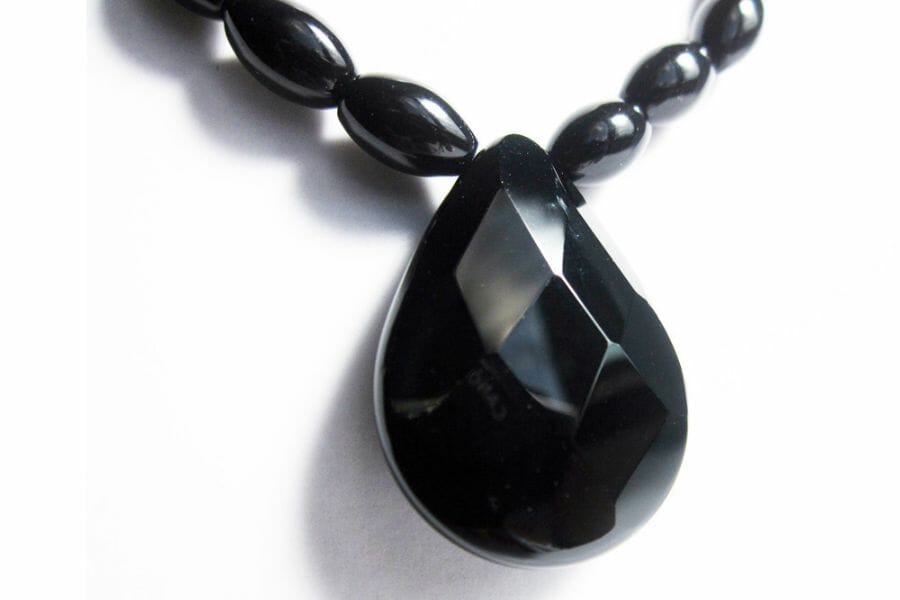
Onyx is a type of banded chalcedony that’s related to quartz. It’s a beautiful and unique-looking gem that’s been used for centuries in jewelry, ornamental carvings, and other decorative items like figurines, bowls, and vases.
The ancient civilizations of Egyptians and Romans used it for amulets and other decors. They believed that it had healing powers, and that it could bring good luck and protection.
In fact, the name “onyx” comes from the Greek word “onux,” which means “fingernail.” This is because the ancient Greeks believed that it was formed from the fingernails of the gods and goddesses.
So, if you’re looking for a unique and beautiful gem for your next home decor or jewelry, Onyx is the one for you!
Fun Fact In many cultures in the past, Onyx has been connected to bad luck, misfortune, and loss of energy. In Arabic, for example, it's called "el jaza", which means "sadness". In China, slaves and low-grade servants used to mine Onyx. But with its wide use in jewelry and home decor today, it has successfully rebuilt its reputation!
Where Onyx is found
Some of the most popular places to find Onyx are Brazil, India, and US. India, for one, is known for producing some of the highest quality Onyx. In the US, California and Utah are known for their onyx mines.
But this gem is not exclusive to these places as it can be found in many other countries, too. So next time you’re on a vacation or hike, keep your eyes peeled and you might stumble upon a beautiful, black Onyx.
How you can identify Onyx
- Color: Onyx is most commonly known for its black and white banded appearance (kinda like a yin-yang symbol) but it can also come in other colors. You can find onyx in shades of red, yellow, blue, green, and even pink.
- Hardness: Onyx has a hardness of around 6-7 on the Mohs scale, which is kind of in the middle of the pack for gems. It’s not as hard as a diamond, but it won’t scratch as easily as a piece of glass.
- Clarity: Onyx can range in clarity from transparent to opaque, depending on its color. The black and white banded variety is usually opaque. Some specimens that are translucent or opaque can also have inclusions or bubbles, which can add character and uniqueness to it, but also makes it less valuable than a clear one.
- Refractive index: Onyx has a moderate refractive index, which means it has a moderate level of sparkle. However, the refractive index can vary depending on the specific content and structure of the specimen, so it’s not a definitive value.
- Specific gravity: Onyx has a specific gravity that typically ranges from 2.5 to 2.9, which means it is relatively heavy for its size, but not as heavy as some other gems. With this weight and density, Onyx is great for jewelry.
Hematite – Fe2O3
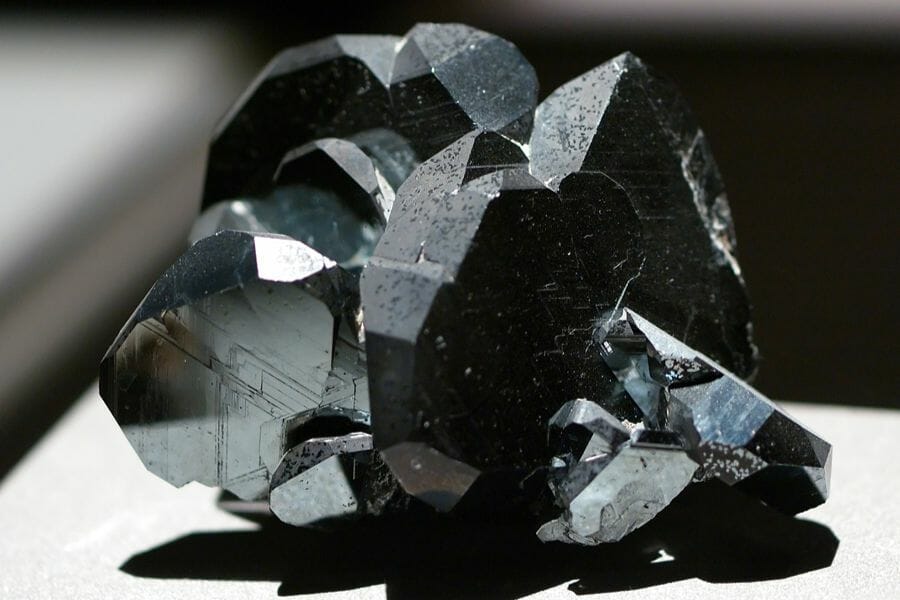
Hematite, also known as “bloodstone”, is a type of iron oxide. It has been used for centuries for its unique properties: it’s been used as a pigment for paint, as a gemstone in jewelry, and as a tool for divination.
In ancient times, it was believed that Hematite had magical properties, so it was widely used in amulets and talismans. It was also used as a means of protection, and it was believed that it would bring good luck and banish negative energy.
Aside from being valued for its unique metallic shine, which makes it a popular stone for jewelry, it’s also used in industrial applications, such as in the production of iron and steel. There’s really so much more to Hematite than just its dazzling beauty!
Fun Fact While Hematite is NOT magnetic and, therefore, should not be attracted to common magnet, some specimens of Hematite contains Magnetite, making it responsive to common magnet. Because of this, Hematite can be mistaken for pure Magnetite (which we will discuss below!) or Pyrrhotite. Want to know how to decipher them? Look for a reddish streak! Hematites will always have a reddish streak, which the other two gemstones don't have.
Where Hematite is found
Hematite can be found all over the world: in places like Brazil, Russia, Australia, and the US, just to name a few. These little guys are like the globetrotters of the mineral world.
You can find them in volcanic rocks, in sedimentary rocks, and even in meteorites (whoa!) So if you’re ever on a rock hunting adventure, be alert for these shiny stones. They might just surprise you and pop up in the most unexpected places!
How you can identify Hematite
- Color: Hematites are usually shiny, metallic black, or silver-gray in color. They look almost like they’ve been dipped in liquid metal. But sometimes, due to impurities, they can have a reddish or brownish tinge.
- Hardness: Hematite’s hardness is pretty tough at 6-6.5 on the Mohs scale. It’s hard enough that it’s not easily scratched, but still not as hard as a diamond. So while it can withstand everyday wear and tear, you still need to be careful if you’re gonna use it for jewelry or home decor.
- Clarity: Hematite is not see-thru at all. It’s usually opaque, which makes it all the more interesting. It’s got a metallic luster that can vary from a silver-gray to black, and a unique, earthy look that can add a touch of ruggedness to any piece of jewelry or decor.
- Refractive index: Hematite’s refractive index is pretty average for a gem. That is, it’s not as sparkly as some other gems, but it’s got a unique, earthy look that makes up for it.
- Specific gravity: Hematite’s specific gravity is pretty heavy for a gem. It’s a bit denser than regular rocks you’d find around, which makes it easy to spot in a pile of pebbles. It’s also heavier than other materials that it’s often confused with, like magnetite or limonite.
Neptunite – KNa2Li(Fe2+, Mn2+)2Ti2Si8O24
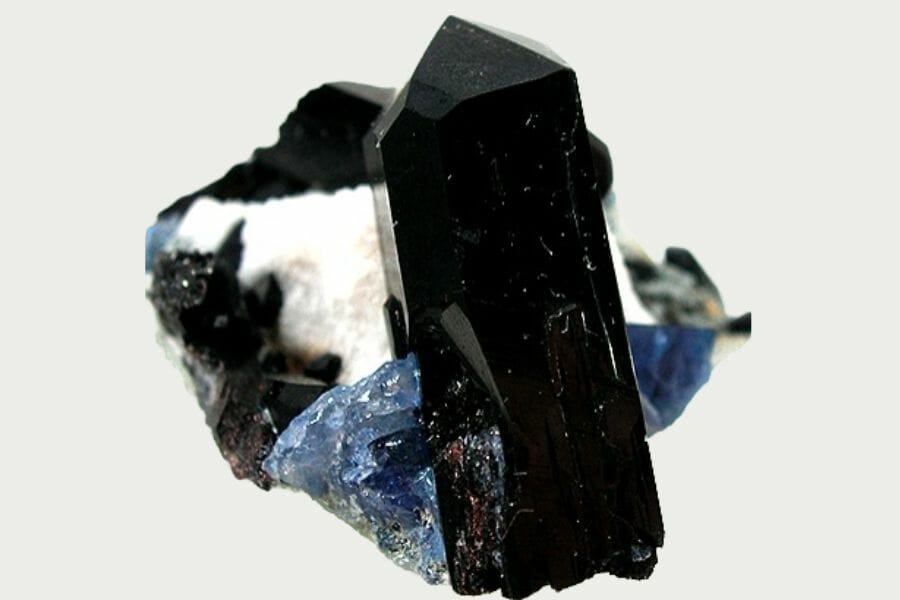
Known for its unique appearance and properties, Neptunite was first discovered in California in the late 1800s. It was named after Neptune, the Roman god of the sea, due to its color that’s associated with the deep, dark ocean.
This gemstone is a type of silicate and is found in a variety of different colors including black, brown, and green.
Despite its unique and dazzling appearance, it’s not widely used in jewelry or other applications. But for those with eyes for beautiful gems like collectors and enthusiasts, it is a highly-valued one!
Fun Fact:
If you're ever wondering whether your new gemstone is a Neptunite, just put it under the sun and see if it glows. That's right! Neptunite's fluorescence makes it glow under ultraviolet light. Such a cool find!Where Neptunite is found
Neptunites are found in a few special spots, mostly in California, USA. They’re hidden deep in some old mines, and you gotta know where to look. But trust us, it’s worth the hunt! These gems can also be found in Russia and Madagascar, but they’re rarer there.
How you can identify Neptunite
- Color: Neptunite’s color is likened to the darkness of the deep ocean. Its rich, black color makes it stand out in uniqueness.
- Hardness: Neptunite’s hardness on Mohs scale is quite high at around 6-6.5, making it pretty tough. It won’t scratch easily and can handle a little bump or two, so you’ll need a pretty strong tool to make a mark on it.
- Clarity: Neptunite’s clarity can range from translucent to opaque, with a few stones having a glassy luster. It’s not known for its clarity, but its unique black color and crystal formations make it highly valued by collectors.
- Refractive index: Neptunite’s refractive index is relatively high, giving it a lustrous appearance compared to other gems. It’s a unique property that makes it stand out, and is one of the reasons why this gem’s sought after by enthusiasts!
- Specific gravity: Neptunite’s specific gravity indicates that it’s slightly heavier than your average gem. So if you hold it in your hand, you’ll feel that it’s got some weight to it, but not super heavy.
Jet – C. (Carbon, plus impurities)
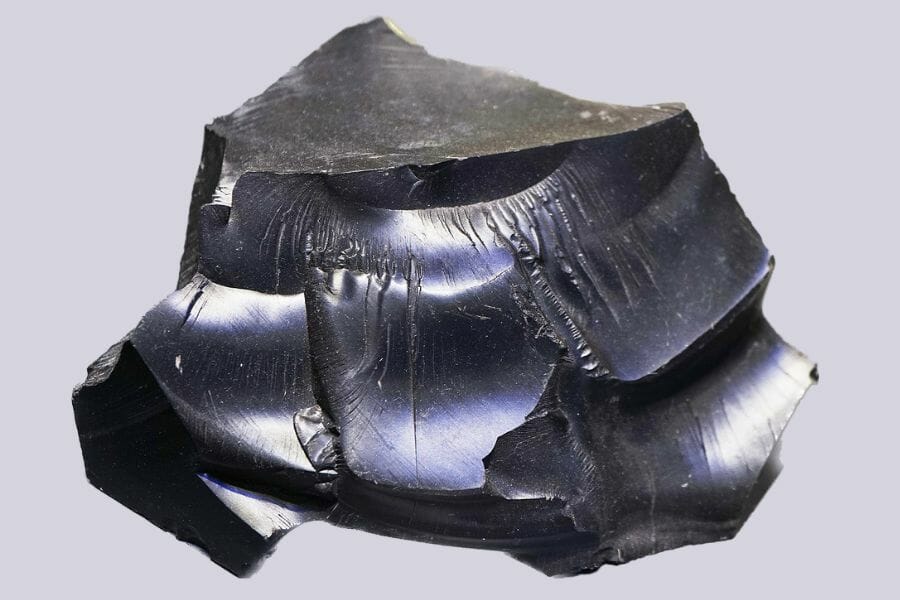
This gem’s glamour has been prized for thousands of years! Jet has been used for jewelry and other decorative items since prehistoric times. It’s a dense, lightweight gem that’s been found all over the world.
Jet has always been in demand because of its beautiful, glossy black color and its affordability compared to other equally beautiful gemstones. In ancient times, it was often used for mourning jewelry and was believed to have mystical properties.
The Romans carved it into intricate shapes and used it in jewelry and other decorative items, and it was also a popular material for Victorian jewelry.
Jet has also been used in traditional medicine, with people believing it had the power to ward off evil spirits and provide protection. It was also thought to have healing properties and was used in various remedies.
Fun Fact: Did you know that, because of Jet's deep, rich black color, it has been largely used in religious items such as the cross and rosary beads? Truly, it's beauty and mystery all in one gem!
Where Jet is found
Jets are found all around the world, but some of the most famous places they’ve been discovered include England, Spain, and the USA. The process of finding Jet, though, is worth mentioning here because it’s quite unique!
Being a hardened and compacted type of coal, this gem is dug outta the ground before it is formed into beads, sculptures, and other decorative objects.
How you can identify Jet
- Color: As deep black and sparkly as the midnight sky — that’s what a Jet looks like! It’s got a smooth, polished finish that makes it glisten in the light.
- Hardness: Jet’s hardness is at 2.5 to 4 on Mohs scale. Meaning, it’s not as hard as diamonds, but it’s tough enough to be carved into beautiful jewelry. Its hardness makes it easier to carve and shape, but also means it’s more prone to scratches and chips.
- Clarity: Jet’s clarity can vary greatly: sometimes, it’s completely opaque and sometimes it’s got some translucent areas. But overall, it’s a solid, dark black stone with a smooth and polished surface. Its unique color and texture are what make it special!
- Refractive index: Jets don’t have the typical refractive index that other gemstones have. It has a dark, rich luster that’s highly prized by many. They absorb light, making them look almost black.
- Specific gravity: Jet’s specific gravity typically ranges between 1.30 to 1.40. It is a lightweight gem, making it ideal for use in jewelry and other decorative items that don’t weigh down the wearer.
Schorl – NaFe2+3Al6(Si6O18)(BO3)3(OH)3(OH)
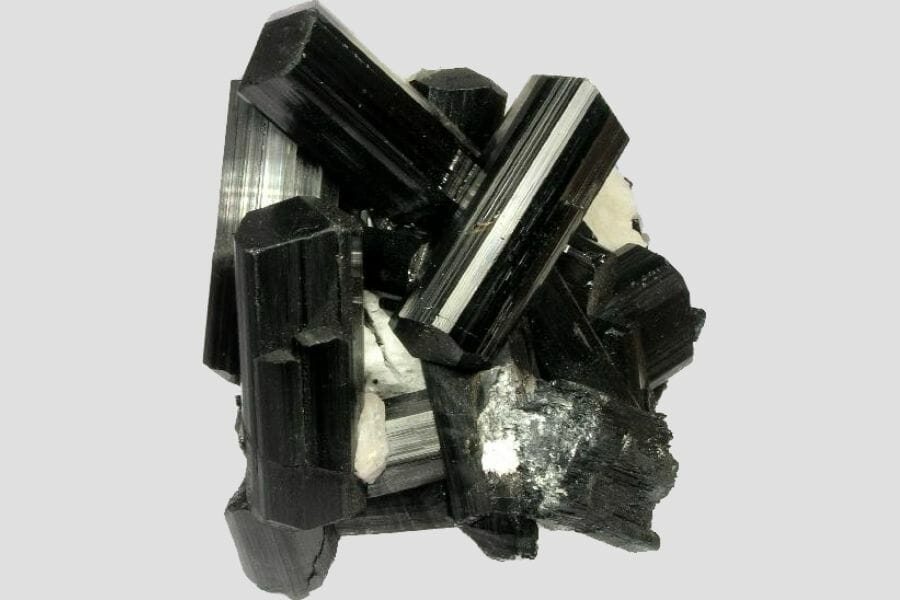
Schorl, also known as black tourmaline, has been around for quite a while and has been treasured by many different cultures throughout history. It’s a naturally occurring gems with a rich history of use and value, and is still prized today for its unique beauty and versatility.
Made up of boron, aluminum, and silicon, Schorl was first discovered in the Himalayan Mountains in the 17th century, but have since been found all over the world.
This gem has been used in different ways throughout history, from jewelry making to medicine. The ancient Egyptians and Romans believed that the stones had special properties that could heal and protect. Even today, some people believe that Schorl has spiritual and healing properties.
Despite the many uses for Schorl, its beauty has always been its most valuable attribute. Its unique color and natural formation make it highly prized by collectors and jewelry designers alike.
Fun Fact:
When it comes to amazing properties, Schorls don't run out! Did you know that it's naturally electro-statically charged? When heated or rubbed, it can attract bits of debris or even small pieces of paper.
Schorl has also been used for centuries by shamans and healers for its grounding and protective energy. It's said to help balance emotions and stimulate inner wisdom. Pretty awesome, right?Where Schorl is found
Schorls are found in several places all over the world! Some popular spots for Schorl-hunting include Brazil, Africa, and the US, especially in California and Maine. But the biggest deposits of this gem have been found in the beautiful country of Madagascar.
How you can identify Schorl
- Color: Schorl is known for having a deep, dark black color, sometimes with a hint of brown or green, or even a bluish tint. The color’s pretty intense and gives it a dramatic look, especially in big pieces, that’s why it’s a popular choice for jewelry or decorative pieces.
- Hardness: Schorl’s hardness is rated at 7 on Mohs scale, which is considered pretty tough. That’s why this gem is suitable for jewelry and other decorative uses, but won’t withstand heavy wear and tear as well as some other gems.
- Clarity: Schorl is known for its typically opaque appearance, so clarity is not one of its best features. It’s not see-thru, like some gems, but it has its own deep dark beauty that makes it all the more unique!
- Refractive index: Schorl’s refractive index is considered average for gems. It is near that of Quartz, so they may look similar to the untrained eye, but they can be differentiated under magnification.
- Specific gravity: Schorl’s specific gravity indicates that it’s relatively dense for a gem. It is higher than many other common gems and helps it to sink in heavy mineral concentrates when it’s being mined or processed.
Black Rocks
The beautiful gemstones above are not the only ones dazzlin’! Let’s now talk about some of the most interesting black rocks that surely rock (pun intended), too.
Anthracite – C240H90O4NS
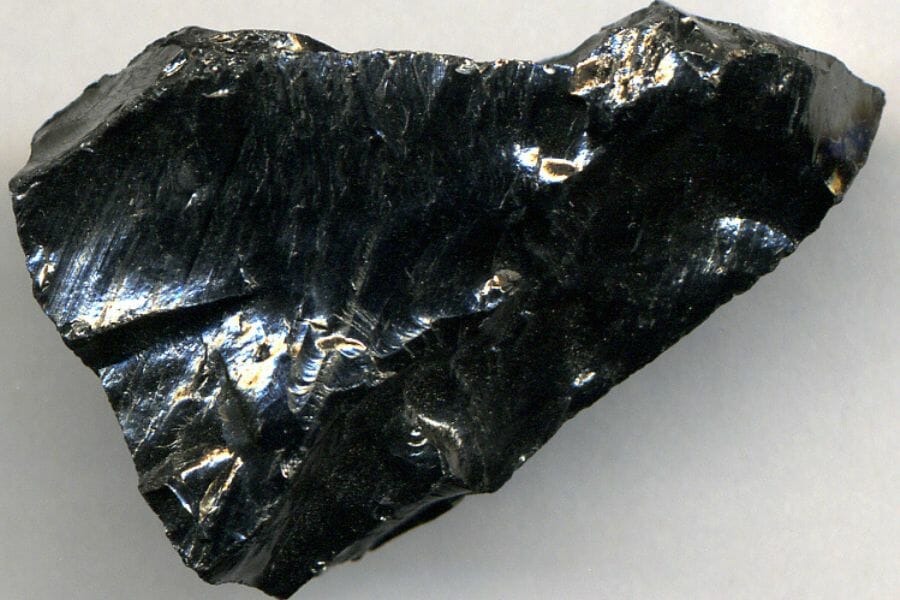
Anthracite or “hard coal” is known for its high carbon content and unique properties. Its rich history dates back to the early 18th century, when it was first mined in the Appalachian region of the United States.
It was a popular fuel source for heating homes and powering trains and steamboats. During the Industrial Revolution, it became even more valuable due to its high energy output and low sulfur content.
Today, Anthracite is still used for a variety of purposes, including heating and electricity generation. It’s also used in the production of activated carbon, which is used to filter and purify liquids and gases.
If you’re a history aficionado, Anthracite might be of interest to you. It played a huge role in the development of many countries, especially the US, and it’s a piece of our country’s story that’s definitely worth learning about!
Fun Fact:
What makes Anthracite so special? Its high carbon content makes it a particularly efficient fuel source. It burns hotter and longer than other types of coal, which means you get more energy out of it per pound. It also has a low sulfur content, which means it produces fewer pollutants when burned.Where Anthracite is found
Anthracites are found in many countries all over the world, but the largest deposits are in the US and China. They can also be found in Australia, Russia, South Africa, Ukraine, and several other countries.
They are usually found in areas that have experienced high pressure and heat over a long period of time, which have resulted in the formation of high-quality coal.
How you can identify Anthracite
- Color: Anthracite is known for its glossy black color. It’s an extremely hard and dense material, with a distinctive, glass-like appearance that sets it apart from other rocks. It is formed from the compression and heat of organic materials over millions of years, which give it its unique characteristics.
- Hardness: Anthracite has a hardness of 2-2.5 on the Mohs scale, which is relatively low. Despite this, it is durable and has a long lifespan, making it a valuable resource for energy production. With it’s high carbon content, it also has industrial uses in iron production and for the filtration of water and air.
- Clarity: Anthracite doesn’t have a clarity like that of gems or minerals. It’s an opaque, black rock, but it does have a unique appearance with a smooth, glassy texture and it’s shiny when polished. Some people even use it for jewelry or decor!
- Refractive index: Anthracite doesn’t have a refractive index since it’s not a gemstone or a mineral. No variety of this rock is transparent. It’s purely opaque and has a black color.
- Specific gravity: Anthracite’s specific gravity is relatively high due to its high carbon content. It’s the densest of all coals and is the least likely to ignite. The high specific gravity also makes anthracite a good sinking material in water treatment processes, as it settles quickly.
Merlinite – Ba(Mn2+)(Mn4+)8O16(OH)4
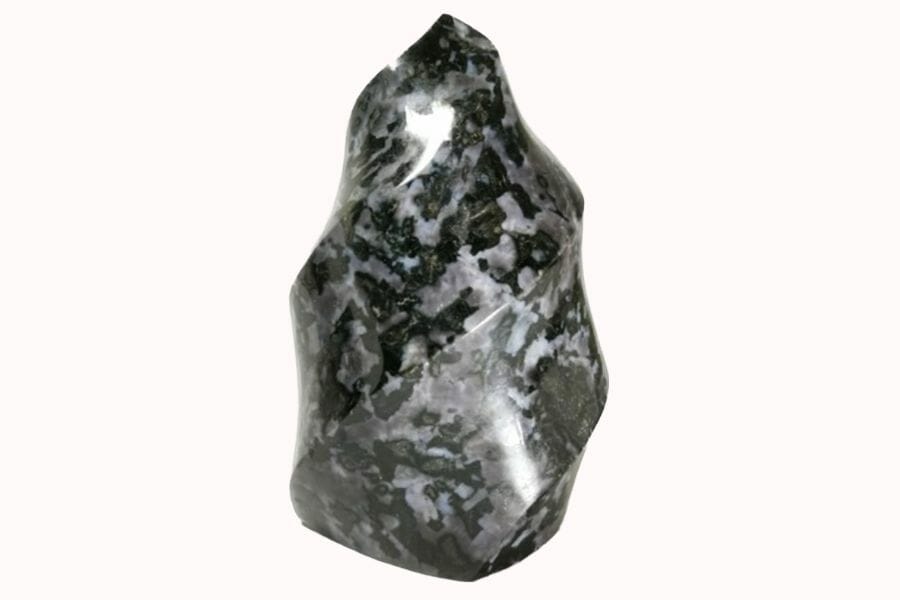
Merlinite is a type of rock that’s formed from volcanic ash and clay, which’ve been compacted over time. They’re highly prized for their unique and striking patterns of black, white, and sometimes, shades of grey.
Merlinites have been used for various purposes throughout history. For example, indigenous tribes in the western US used them for spiritual and ceremonial practices. They’ve also been used as a source of natural dyes and pigments, as well as in jewelry-making.
One of the main reasons Merlinites are so valued is because of their unique appearance. Their unique combination of colors and patterns make each Merlinite truly one of a kind.
Fun Fact:
Merlinite is known for its unique, swirling patterns of black and white, reminiscent of ancient mystical symbols. This rock has been used for spiritual purposes, with some people believing it has the power to help connect with higher realms and bring about positive change.
Legend has it that Merlin himself used Merlinite to tap into his magical abilities and foretell the future. Despite its relatively recent discovery, Merlinite has quickly gained popularity in the world of crystal healing and is now considered a valuable addition to any collection.Where Merlinite is found
Merlinites are found in various locations worldwide, but some of the most notable places for these rocks include Mexico, USA, and Peru. Some places in Mexico are known for producing high-quality Merlinite specimens.
These are also found in various parts of Peru, specifically in the Andes Mountains, and have been known to have formed in volcanic and hydrothermal environments.
How you can identify Merlinite
- Color: Merlinite is known for its unique color, which ranges from grayish-black to white with shades of pink, brown and green. These colors are due to the presence of different minerals in the mineral’s structure. The exact color of this rock depends on its location of origin and the type of impurities present in the crystal structure.
- Hardness: Merlinite’s hardness based on Mohs scale is typically between 4 to 5, making it a relatively soft rock. Its softness can make it prone to scratches and damage. In jewelry making, it’s often used in pendants, earrings, and other items that don’t undergo much wear and tear.
- Clarity: Merlinite’s clarity is typically opaque, meaning it’s not see-thru. It can have a few tiny inclusions, but these are usually not noticeable to the naked eye.
- Specific gravity: Merlinite’s specific gravity is around 2.6-2.7, which is considered average. This falls in between that of most other rocks, making it neither too heavy nor too light.
Basalt – CaMgO6Si2
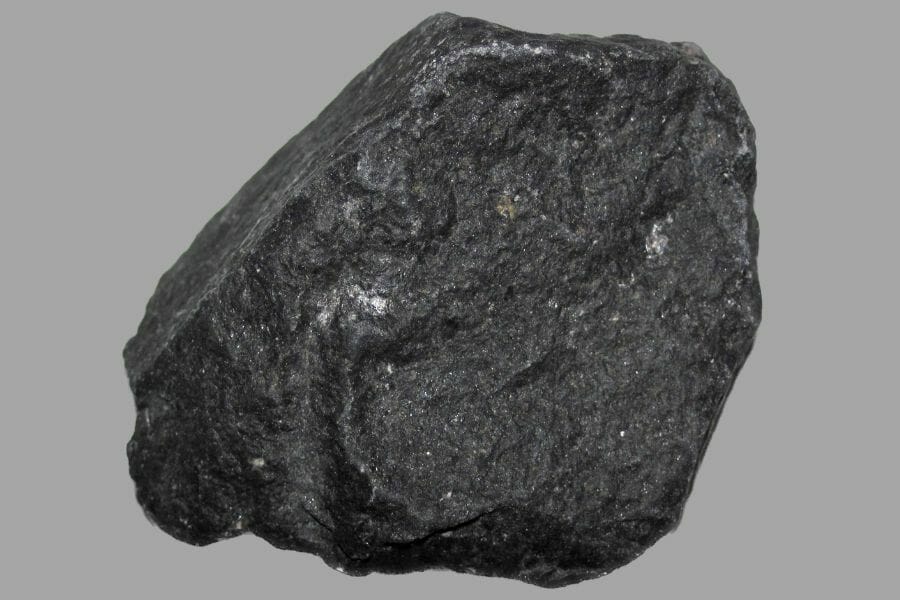
Basalt is a type of volcanic rock that’s formed from the solidification of molten magma. It has been used for thousands of years as a building material due to its durability and strength. In ancient times, it was used to make tools, weapons, and even sculptures!
Basalt has a dark, dense, and fine-grained texture and is often used for road construction and as a filler material in concrete. Its fibers are also used in the production of composite materials for high-temperature applications.
Additionally, it has been used for the production of stone wool insulation and geothermal heating systems due to its heat resistance. Basalt is also valued for its use as a decorative stone in landscapes, gardens, and aquariums.
Overall, the versatility of Basalt and its durability have made it a valuable resource for many industries and applications. Whether used for construction, insulation, or decoration, it has proven to be an essential and valuable natural resource.
Fun Fact: Basalt is the third most abundant material on Earth's ground after Feldspar and Quartz. In fact, it's so abundant, it was even found on the moon, Mars and other planets!
Where Basalt is found
Basalt is a volcanic rock that’s found all over the world, but mainly in areas with active volcanoes or with recent volcanic activity. They’re commonly found on oceanic islands, such as Hawaii and Iceland, as well as in certain parts of the mainland, such as the western US and the eastern Mediterranean.
It also makes up much of the ocean floor, where they form through underwater volcanic eruptions. They’re often found in large volcanic plateaus, such as the Deccan Traps in India, and are a key component of large igneous provinces, which are areas that’ve experienced massive volcanic eruptions in the past.
How you can identify Basalt
- Color: Basalt’s color is usually dark, ranging from dark-grey to almost black. Since it’s formed from cooled lava, it can contain iron, magnesium, and other minerals that give it its dark hue. It’s color is also known to vary depending on its location and the minerals that are present in the surrounding area.
- Hardness: Basalts have a hardness of 5-6 on the Mohs scale. It’s not a very hard rock, but it’s still durable enough for many common uses, such as for building, landscaping, and construction purposes. Its hardness is similar to that of a fingernail, so it can be scratched relatively easily.
- Clarity: As a volcanic rock, Basalt is not known for its clarity. It’s usually dark and opaque in appearance, with little to no translucency. It has a uniform, dense texture, and as a result, it usually doesn’t exhibit any clear areas or visible inclusions.
- Refractive index: Basalt, in general, has a moderate refractive index. However, it may vary in different specimens since the refractive index depends on factors like mineral composition, crystal size, and texture.
- Specific gravity: Basalt’s specific gravity varies depending on its chemical composition, but it’s generally considered to be fairly dense for a volcanic rock. It falls in between that of an average metamorphic rock and a plutonic rock. This gives clues about its origin, magmatic history, and changes it underwent after formation.
Coal – No fixed chemical formula
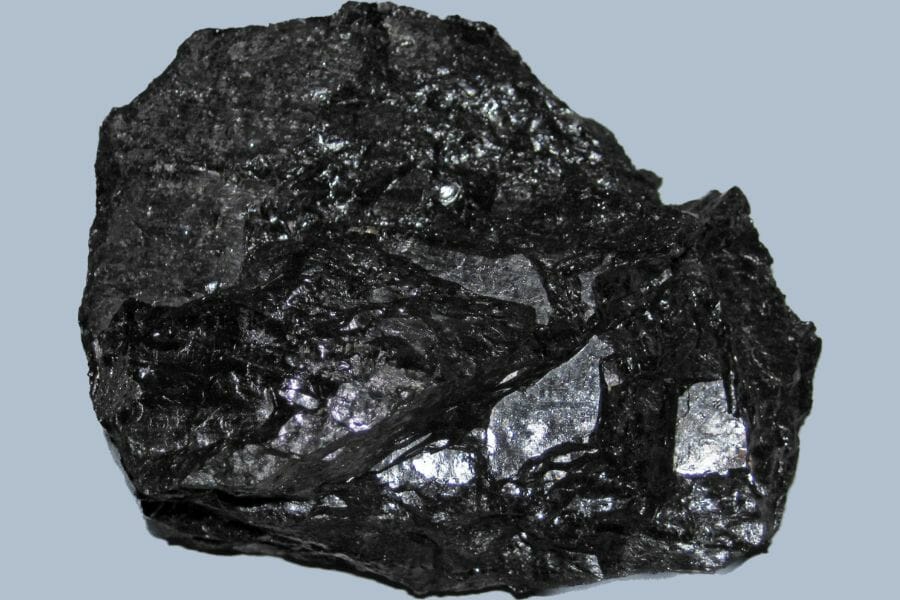
Coal is a sedimentary rock that is primarily composed of carbon, along with hydrogen, sulfur, oxygen, and nitrogen. It has been used for centuries as a fuel source, particularly for heating and electricity generation.
It was used as a fuel in China as far back as 3,000 years ago. It was first widely used in Europe during the Industrial Revolution in the 18th and 19th centuries, when it became a fuel source for steam engines and industrial processes.
In the 20th century, it became the dominant energy source for electricity generation, with the majority of power plants relying on coal-fired boilers.
Despite its widespread use and relatively cheap price compared to other energy sources, coal has faced criticism for its negative impact on the environment. That’s why efforts have been made to reduce its environmental impact, including the development of cleaner coal technologies and the increased use of renewable energy sources.
Fun Fact: Coal is the largest source of energy for electricity generation in the world at over 40%. In fact, in 2022, the global coal use surpassed 8 billion tonnes in a single year, which is the highest record since 2013.
Where Coal is found
Coal is found in many parts of the world, including North America, South America, Europe, Asia, and Australia. It’s typically located in underground mines, although some are also found in open-pit mines.
In the US, the largest coal-producing states are Wyoming, West Virginia, Kentucky, Pennsylvania, and Montana. In Australia, it’s Queensland and New South Wales. Russia, China, and India are among the largest coal-producing countries in the world.
The location of coal deposits is determined by a variety of geological factors, including the type of rock formations in which it is found, as well as the presence of certain minerals and other substances that are necessary for coal to form.
How you can identify Coal
- Color: Coal’s color can vary, ranging from black to dark brown, depending on its type. Bituminous coal is often referred to as “soft coal” and is black in color. Lignite coal, also known as “brown coal,” is brownish-black in color and is the youngest and least mature type of this rock. Regardless of the type, coal is generally considered to be a dark, opaque mineral.
- Hardness: Coal is a relatively soft mineral with a hardness that generally ranges from 1-3 on the Mohs scale. Its hardness can also vary within the same deposit, as different layers of this rock can have varying levels of compression thta affects hardness. In general, the older and more compressed a coal deposit is, the harder it will be.
- Clarity: Clarity is not a property of Coal, since it’s not a transparent material. It’s an opaque and dull-looking rock with a black or dark brown color.
- Refractive index: Coal doesn’t have a refractive index because it’s a solid, non-transparent material. Refractive index is only applicable to transparent or translucent substances.
- Specific gravity: Coal’s specific gravity varies based on type and quality. But, generally, its specific gravity as well as its other physical properties affect its use and value. Coals with a high specific gravity are denser, contain more carbon, and burn hotter, so it’s often used in power generation.
Black Minerals
If you’re here to know about black minerals, we have a pretty good list of some of the most beautiful and dazzling ones you can find.
Galena – PbS
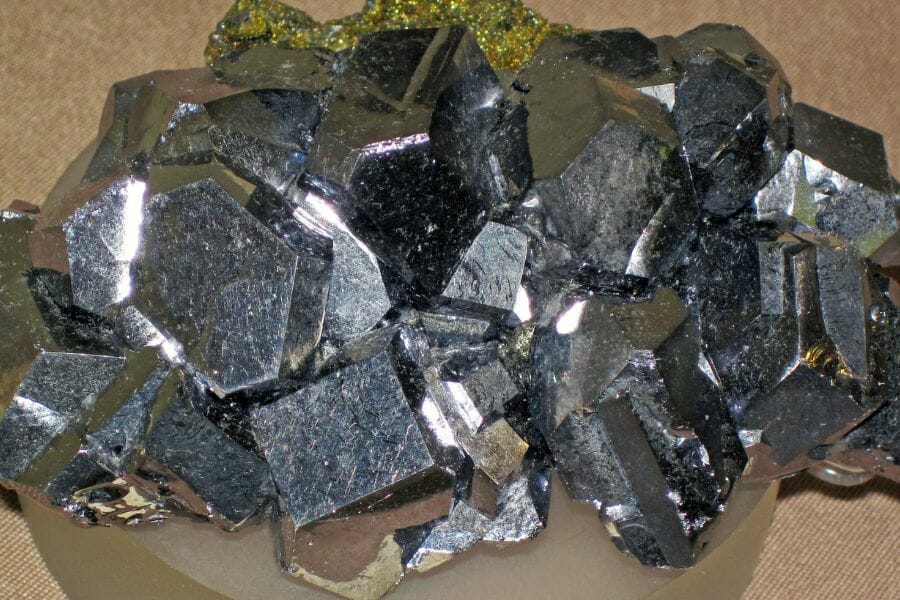
Galena has been known and used for thousands of years, as far back as ancient civilizations in the Mediterranean and Middle East. It was an important source of lead for many centuries, but fell out of use when more efficient methods of obtaining lead were discovered.
It wasn’t until the 19th century that it once again became an important resource, this time as the primary ore of lead.
Because of its high lead content, it’s valued in the production of lead-based products such as batteries and radiation shielding. It’s also a popular mineral among collectors and rockhounds due to its distinctive metallic luster and crystal habit.
Today, Galena is still a major source of lead, but the environmental impact of lead mining and processing has led to regulations and restrictions on its use. Despite this, it remains a valuable mineral, both economically and aesthetically.
Fun Fact: Galena was one of the first minerals used by humans. Lead from galena was used in making pipes and vessels, as well as pigment in makeup and stained glasses, weights in fishing nets, and ingredient in medicines. It was also used by the ancient Egyptians for making jewelry, and by the Romans for making lead-based wine cups.
Where Galena is found
Galena is found in various regions worldwide, but it’s widely distributed in Europe, Canada, US, Australia, and some parts of Africa and South America. In the US, the lead-rich mineral can be found in states like Missouri, Oklahoma, Kansas, and others.
In Canada, some of the regions that yield it include Ontario, Quebec, and British Columbia. Galena is often found in sedimentary rocks like limestone, dolostone, and shale, and is often extracted as a by-product of zinc, silver, and copper mining.
How you can identify Galena
- Color: Galena’s color is a shiny, metallic silver-grey or silver-black, depending on the lighting conditions. It has a high luster due to its high lead content, making it easily distinguishable from other minerals.
- Hardness: Galena is a soft mineral with a Mohs hardness of 2.5-2.8, so it’s relatively easy to scratch or cut compared to other minerals. It can often be found in a cubic crystal form as the photo above shows.
- Clarity: Galena’s clarity can vary from clear to opaque, depending on the amount of impurities present. It can also have a dull or metallic luster. The presence of other minerals in a Galena can affect its clarity.
- Specific gravity: Galena’s specific gravity is relatively heavy for a mineral. It means it’s denser than most other minerals and has a heavier feel in hand. Its high density is due to the heavy elements, lead and sulfur, that it contains.
Magnetite – Fe2+Fe3+2O4
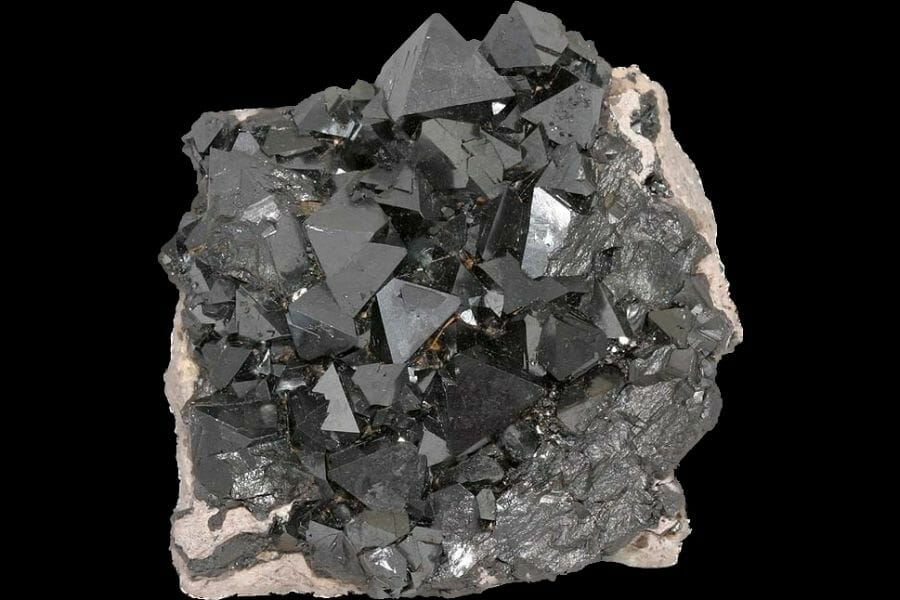
Magnetite, also known as lodestone, is a naturally occurring mineral that’s been valued for thousands of years. It’s been used for various purposes, such as for compasses in navigation, for jewelry, and as a source of iron.
The mineral’s name comes from its magnetic properties, which were discovered by ancient people who noticed that pieces of the mineral were attracted to each other and to metal objects.
This mineral is abundant in nature and can be found in a variety of rock types, including igneous, metamorphic, and sedimentary rocks.
Magnetite is often used as a source of iron ore and an important component in the steel-making process. In addition, its high magnetic susceptibility makes it useful in various industrial applications, such as in magnetic separation processes in the mining industry.
Fun Fact:
Have you heard of "Magnetic Therapy"? This kind of therapy uses Magnetite, which is believed to have therapeutic properties. So much so that this mineral is also often used in jewelry, such as necklaces, bracelets, and earrings, to harness its health benefits and improve the wearer's energy levels. Doubtful? Try it on!Where Magnetite is found
Magnetites are found in various regions across the world, such as Europe, Asia, Africa, and North and South America. Magnetite is also found in iron-rich meteorites, and in some beach sand deposits, where it’s concentrated by wave action and wind.
They’re also sometimes found in association with iron deposits and as a result of volcanic activity. Some Magnetites are also found in man-made materials like cement and concrete where it’s used as a component of iron ore.
How you can identify Magnetite
- Color: Magnetite is usually black or grey, sometimes with a metallic sheen. They’re naturally occurring minerals, so the exact shade can vary, but the color is generally consistent within a single deposit or area.
- Hardness: Magnetite’s hardness is 5.5-6.5 on the Mohs scale, making it relatively soft and similar to most types of glass. It can be scratched easily, but it’s still durable enough for many uses, especially as a heavy aggregate in construction and as a magnetic material in industry.
- Clarity: Magnetite’s clarity can vary from transparent to opaque. It can have a metallic luster, appearing to be shiny and reflective when cut or polished. But due to its iron content, Magnetite can also appear dark and dull with a matte finish. The clarity of a specimen depends on its mineral composition, size, and shape.
- Refractive index: Magnetite’s refractive index is approx. 2.2. It’s not transparent, so it’s not suitable for faceting or gem-like use, but it does have a metallic luster that makes it popular for jewelry and other decorative items.
- Specific gravity: Magnetite’s specific gravity is relatively heavy compared to other minerals. It’s almost twice as heavy as common rocks. This makes it a bit dense, which is why it’s sometimes used as a weighting agent in industrial applications.
Ferberite – FeWO4
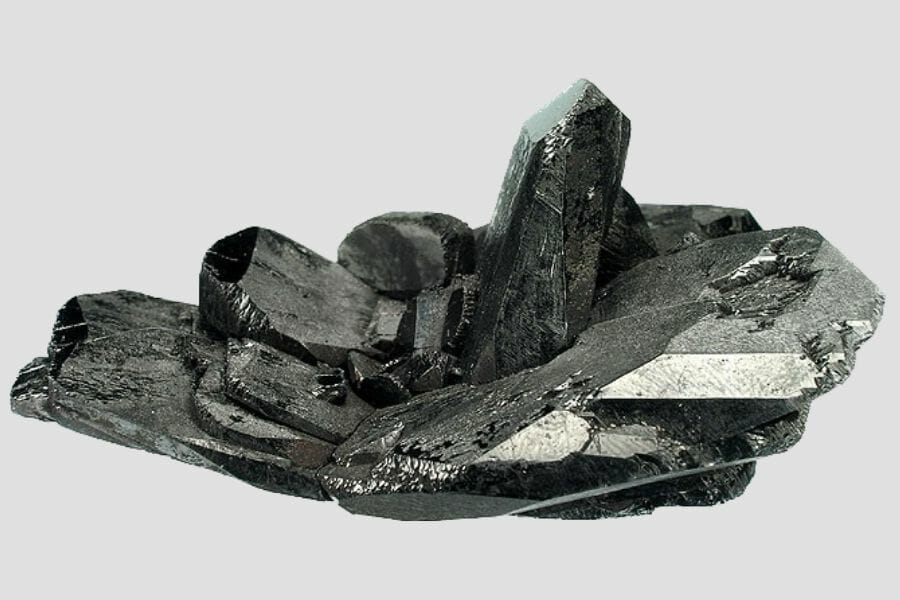
Ferberite is a rare mineral that was first discovered in the mid-19th century. It belongs to the tungstate group of minerals and is commonly found in hydrothermal veins, skarn deposits, and granite pegmatites.
Ferberite has been used for centuries in the production of tungsten, also known as wolfram, a metal that has many industrial applications.
Ferberite is also valued for its rarity and its unique physical properties, which make it an interesting mineral for collectors and researchers.
This mineral has a metallic luster, and its black color gives it a striking appearance. Its rarity, unique physical properties, and high tungsten content make it highly sought after by collectors and researchers.
Fun Fact:
Ferberite is valued for its high content of tungsten, an important metal that is used in the production of steel alloys, electronic components, and aerospace applications. It might even be in your light bulbs!Where Ferberite is found
Ferberites are primarily found in hydrothermal veins and contact metamorphic zones, mainly in areas with a volcanic history. They are commonly found in countries such as Russia, China, and Peru.
Ferberite is also found in smaller quantities in other countries, such as Germany, Austria, and the US, but these are just some of the main locations.
How you can identify Ferberite
- Color: Ferberite is a dark-brown to black colored mineral. It has an opaque appearance with a metallic luster.
- Hardness: Ferberite’s hardness is at 7.5 on the Mohs scale, making it one of the hardest minerals known to man. It is very resistant to scratches and abrasions, even a knife or a saw can’t easily scratch or cut it!
- Clarity: Ferberite’s clarity is usually (very) good, with few inclusions or blemishes. It can be described as translucent to opaque, with occasionally a glassy luster. It’s rarely transparent, but when it is, it can display a vitreous to sub-adamantine luster. It’s common for the clarity of Ferberite to be affected by its iron content – the more iron present, the less clear it’ll be.
- Refractive index: Ferberite’s refractive index is typically 2.80-2.90. It’s known for its strong double refraction and for displaying a distinct orange-red color when viewed under shortwave UV light.
- Specific gravity: Ferberite’s specific gravity indicates that it’s relatively heavier than most minerals.
Psilomelane – Ba(Mn2+)(Mn4+) 😯 16(OH) 4
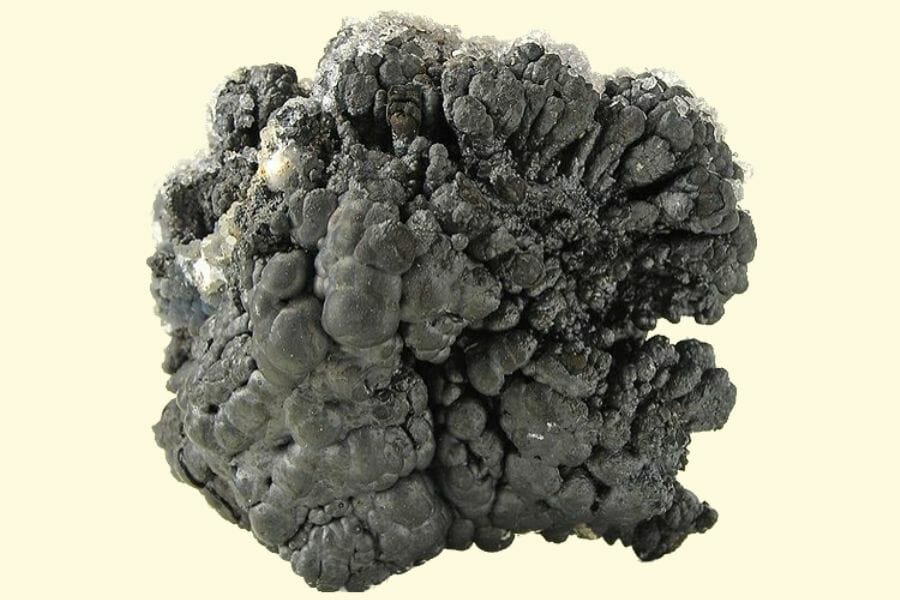
Psilomelane is a manganese oxide mineral that is commonly found in sedimentary manganese deposits. Its history dates back to the 18th century, when it was first discovered in England. Since then, it has been used for various purposes, including as an important component in the production of batteries, fertilizers, and pigments.
Psilomelane is also a valuable mineral for collectors due to its interesting texture, color and rare occurrence. Its texture is earthy and dull, making it less appealing for jewelry use. However, it has been used in the production of fine art pigments, as well as in ceramics and pottery as a glaze.
Despite its less-than-spectacular appearance, Psilomelane is an important mineral for industry due to its high manganese content, which makes it an essential ingredient in the production of ferromanganese alloys.
Fun Fact:
Psilomelane is also known as "stone of luck" because it is believed to bring good fortune and prosperity to those who carry it. This belief stems from various cultures and traditions, where it has been regarded as a talisman to attract good luck, wealth, and success.
Whether it brings good fortune or not, Psilomelane remains a unique and beautiful mineral that is treasured for its rarity in nature!Where Psilomanes is found
Psilomelanes are commonly found in places such as Brazil, Australia, Africa, and US, mainly in California and Oregon. They are often found in ancient volcanic rocks and can also occur as nodules in sedimentary rocks.
They can sometimes be found in black sand deposits along coastal areas or as a result of weathering of manganese ore deposits.
How you can identify Psilomane
- Color: Psilomelane’s color is usually black or dark grey. Its chemical composition usually results in this unique, dark color. It can also have a metallic luster and (sometimes) a bluish or purplish tint to it.
- Hardness: Psilomelane’s hardness varies from 2.5 to 5.5 on Mohs scale, depending on the location and formation. It’s a relatively soft mineral and can easily be scratched with a fingernail. However, it’s still hard enough to be used for jewelry or decorative items.
- Clarity: Psilomelane is an opaque mineral, which means it doesn’t allow light to pass through it, so it doesn’t have a clarity. While it’s a black, iron-rich mineral with a metallic luster, it may sometimes have white streaks or veins of lighter-colored minerals in it.
- Specific gravity: Psilomelane’s specific gravity is approx. 4.8-5.2 (depends on type), so it’s considered heavier than average for a mineral. It’s much denser than water, so it sinks in it.
Shungite – C60
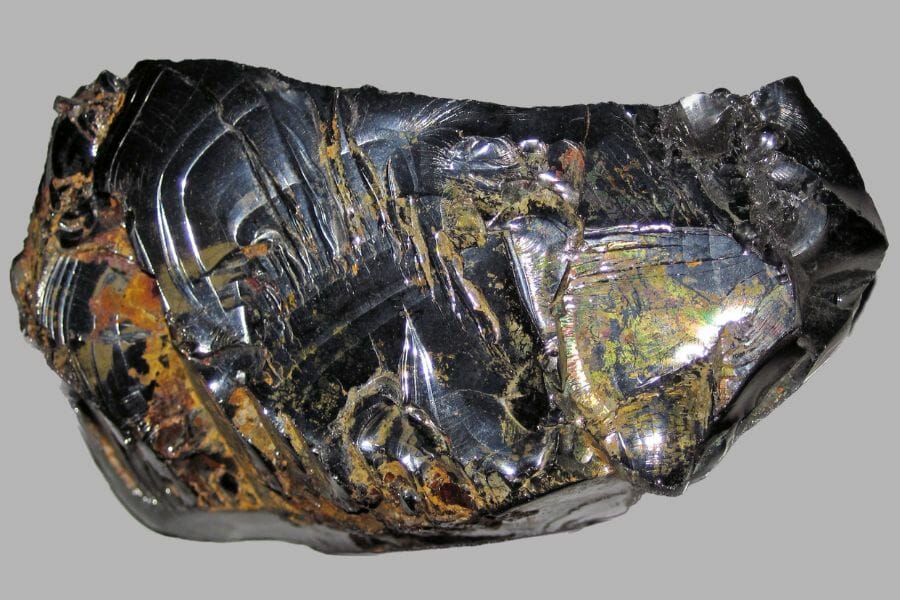
This interesting material is said to be one of Earth’s oldest minerals. That’s right! Shungite is a non-crystalline carbon mineral that was formed over 2 billion years ago.
It’s valued for its unique composition, which includes high levels of fullerenes, carbon-based molecules that are found in only a few other places in the world.
In the past, Shungite has been used for medicinal purposes, believed to have healing properties for a variety of ailments. It was also used to purify water, as its properties make it highly effective at removing impurities.
Today, it is still used for water purification and is often made into jewelry due to its grounding and protective properties, which are said to balance the wearer’s energy and protect against electromagnetic radiation.
Despite its popularity, Shungite is still relatively unknown to many people outside of Russia, making it a valuable and fascinating mineral to learn about!
Fun Fact:
Did you know that Shungite is believed to help reduce stress and improve sleep quality? In fact, other people also believe that it can boost their immune system and overall physical health. While the science behind these benefits is still being studied, many people report positive effects from using Shungite. Somethin' worth trying!Where Shungite is found
Shungites are mainly found in one location: the Republic of Karelia in northwestern Russia. It’s said to be one of the world’s only known deposits of this mineral. This region has been a source of this mineral for centuries.
The demand for Shungite has led to the development of mines in the Karelia region, and the mineral is now widely available for purchase today.
How you can identify Shungite
- Color: Shungite’s color is usually black, with a slight grey or brownish tint. It’s a unique mineral with a very distinct look, making it easily recognizable. The color is due to the high content of carbon and graphite in its composition. It is also known for having metallic luster, adding to its unique appearance.
- Hardness: Shungite’s hardness is 2-2.5 on the Mohs scale, which means it’s quite a soft mineral. It can be scratched easily with a fingernail and can be broken with a gentle pressure. This makes it susceptible to physical damage, but it’s still often used for making beads, statues, and jewelry.
- Clarity: Shungite’s clarity varies depending on the quality of the specimen, but in general, it’s usually opaque. If the specimen contains a high percentage of carbon, it’ll be more dense and opaque, with fewer visible inclusions. On the other hand, if it contains a lower percentage of carbon, it’ll be lighter in color, with a more dull and matte appearance.
- Specific gravity: Shungite’s specific gravity, which is relatively high compared to other minerals, indicates that it’s a heavy, dense material that will sink in water. Its weight makes it stand out and gives it a distinct feeling in the hand.
Graphite – C
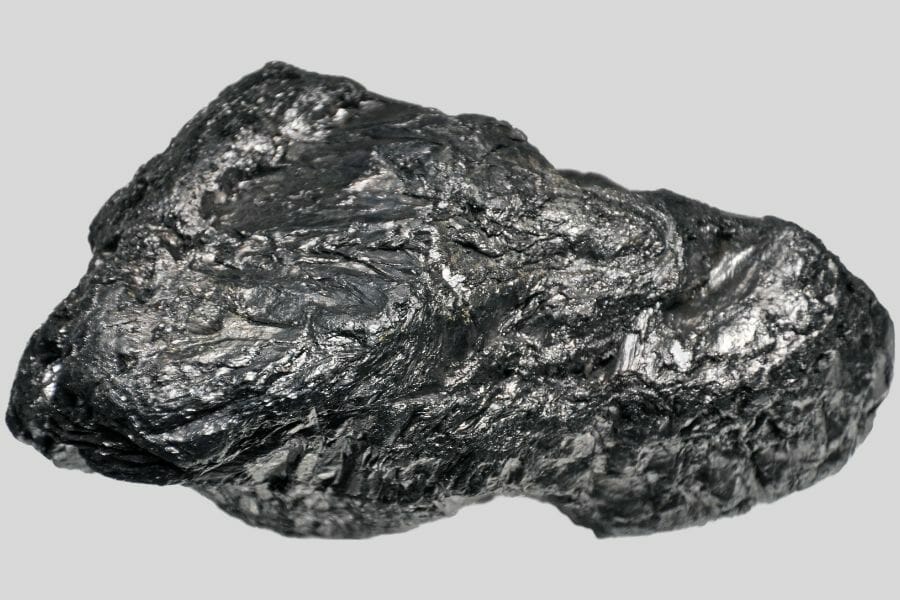
Graphite has a long and rich history (dating back to the 15th century) of being used for a variety of applications due to its unique properties, such as its ability to conduct electricity and withstand high temperatures. It is found in many forms but is most well-known as being the “lead” in pencils.
Graphite is most commonly found in metamorphic rocks and is formed from the alteration of organic material under high pressure and temperature. The value of graphite is determined by its purity and flake size, with large flake graphite being the most valuable.
Graphite is also valued for its unique physical and chemical properties. It is a good conductor of heat and electricity, has high thermal stability, and is resistant to chemical attack. The demand for graphite continues to grow as new technologies and applications emerge, making it a valuable and in-demand mineral.
Fun Fact: Although their properties could not be any more different, Graphite and Diamond are identical in their chemical composition. In fact, scientists have found a way to turn Graphite into 'ultra-thin diamond-like films' without applying pressure.
Where Graphite is found
Graphites are found in many countries around the world, including China (produces over 70% of the world’s Graphite), India, Brazil, North Korea, & the USA. They’re commonly found in metamorphic rocks, especially in areas with high heat and pressure, such as those formed by volcanic activity or the collision of tectonic plates. They can also be synthetic and produced in labs.
How you can identify Graphite
- Color: Graphite’s color is usually black or dark gray due to its carbon content. Graphite has a metallic sheen, and is soft and slippery to the touch that’s why it’s valued for its lubricating properties, too.
- Hardness: Graphite’s hardness varies, but in general it’s considered a soft mineral based on Mohs scale. Some graphites may be harder, but, due to their crystalline structure, they still don’t rate very high on the scale. Its softness makes it useful in many industrial applications, but it’s also why it’s not often used in jewelry or other decorative applications.
- Clarity: Graphite’s clarity is generally translucent to opaque. It lets some light pass through, but not enough to see through completely. Its transparency varies greatly depending on the size and shape of the individual Graphite crystals, as well as the amount of impurities it contains. The purer the graphite, the more translucent it will appear
- Refractive index: Graphite’s refractive index can’t be described with a single value, as it depends on its specific form and the wavelength of light being considered. But in general, it has a low refractive index, which means it doesn’t bend light much as it passes through it.
- Specific gravity: Graphite’s specific gravity is relatively low compared to other minerals. It is soft and light-weight, which makes it float on water. This property is due to its unique crystal structure, which is layered and composed of carbon atoms arranged in hexagonal shapes.

